Refine search
No keyword found to refine search
keywords EN
Places
Names
32 documents found
| 1 |
Documents per page :
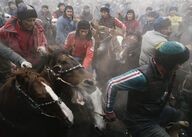
Kokpar in Kazakhstan - An ancient equestrian sport
Gabriel Gauffre / Le Pictorium
LePictorium_0278377.jpg
Kokpar players in the scrum.
Kokpar, a style of horse rugby, where the ball is a weighted goat corpse weighing about 55kg, has been practiced for almost a millennium in Central Asia, and was imported to Kazakhstan from the large intermingling of populations from China and Mongolia.
The goal: to fight for the possession of the ball (the goat), which can only be carried under the rider's leg, stuck against the saddle, and then throw it into a goal, designated on the ground by large circles of white powder. At the beginning of each round, in a fair atmosphere, the commentator announces the prize that will be won by the next scorer - a car, money, cattle, or even a camel.
Kokpar, a style of horse rugby, where the ball is a weighted goat corpse weighing about 55kg, has been practiced for almost a millennium in Central Asia, and was imported to Kazakhstan from the large intermingling of populations from China and Mongolia.
The goal: to fight for the possession of the ball (the goat), which can only be carried under the rider's leg, stuck against the saddle, and then throw it into a goal, designated on the ground by large circles of white powder. At the beginning of each round, in a fair atmosphere, the commentator announces the prize that will be won by the next scorer - a car, money, cattle, or even a camel.
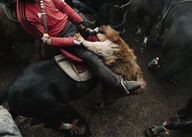
Kokpar in Kazakhstan - An ancient equestrian sport
Gabriel Gauffre / Le Pictorium
LePictorium_0278378.jpg
The goat in possession of a kokpar player.
Kokpar, a style of horse rugby, where the ball is a weighted goat corpse weighing about 55kg, has been practiced for almost a millennium in Central Asia, and was imported to Kazakhstan from the large intermingling of populations from China and Mongolia.
The goal: to fight for the possession of the ball (the goat), which can only be carried under the rider's leg, stuck against the saddle, and then throw it into a goal, designated on the ground by large circles of white powder. At the beginning of each round, in a fair atmosphere, the commentator announces the prize that will be won by the next scorer - a car, money, cattle, or even a camel.
Kokpar, a style of horse rugby, where the ball is a weighted goat corpse weighing about 55kg, has been practiced for almost a millennium in Central Asia, and was imported to Kazakhstan from the large intermingling of populations from China and Mongolia.
The goal: to fight for the possession of the ball (the goat), which can only be carried under the rider's leg, stuck against the saddle, and then throw it into a goal, designated on the ground by large circles of white powder. At the beginning of each round, in a fair atmosphere, the commentator announces the prize that will be won by the next scorer - a car, money, cattle, or even a camel.

Kokpar in Kazakhstan - An ancient equestrian sport
Gabriel Gauffre / Le Pictorium
LePictorium_0278379.jpg
Kurmanbek Turganbek, 26, is a member of the national kokpar team. He lives only from the income of his sporting activity.
Kokpar, a style of horse rugby, where the ball is a weighted goat corpse weighing about 55kg, has been practiced for almost a millennium in Central Asia, and was imported to Kazakhstan from the large intermingling of populations from China and Mongolia.
The goal: to fight for the possession of the ball (the goat), which can only be carried under the rider's leg, stuck against the saddle, and then throw it into a goal, designated on the ground by large circles of white powder. At the beginning of each round, in a fair atmosphere, the commentator announces the prize that will be won by the next scorer - a car, money, cattle, or even a camel.
Kokpar, a style of horse rugby, where the ball is a weighted goat corpse weighing about 55kg, has been practiced for almost a millennium in Central Asia, and was imported to Kazakhstan from the large intermingling of populations from China and Mongolia.
The goal: to fight for the possession of the ball (the goat), which can only be carried under the rider's leg, stuck against the saddle, and then throw it into a goal, designated on the ground by large circles of white powder. At the beginning of each round, in a fair atmosphere, the commentator announces the prize that will be won by the next scorer - a car, money, cattle, or even a camel.

Kokpar in Kazakhstan - An ancient equestrian sport
Gabriel Gauffre / Le Pictorium
LePictorium_0278380.jpg
A player hoists the goat onto his horse.
Kokpar, a style of horse rugby, where the ball is a weighted goat corpse weighing about 55kg, has been practiced for almost a millennium in Central Asia, and was imported to Kazakhstan from the large intermingling of populations from China and Mongolia.
The goal: to fight for the possession of the ball (the goat), which can only be carried under the rider's leg, stuck against the saddle, and then throw it into a goal, designated on the ground by large circles of white powder. At the beginning of each round, in a fair atmosphere, the commentator announces the prize that will be won by the next scorer - a car, money, cattle, or even a camel.
Kokpar, a style of horse rugby, where the ball is a weighted goat corpse weighing about 55kg, has been practiced for almost a millennium in Central Asia, and was imported to Kazakhstan from the large intermingling of populations from China and Mongolia.
The goal: to fight for the possession of the ball (the goat), which can only be carried under the rider's leg, stuck against the saddle, and then throw it into a goal, designated on the ground by large circles of white powder. At the beginning of each round, in a fair atmosphere, the commentator announces the prize that will be won by the next scorer - a car, money, cattle, or even a camel.

Kokpar in Kazakhstan - An ancient equestrian sport
Gabriel Gauffre / Le Pictorium
LePictorium_0278381.jpg
Kokpar players in the scrum.
Kokpar, a style of horse rugby, where the ball is a weighted goat corpse weighing about 55kg, has been practiced for almost a millennium in Central Asia, and was imported to Kazakhstan from the large intermingling of populations from China and Mongolia.
The goal: to fight for the possession of the ball (the goat), which can only be carried under the rider's leg, stuck against the saddle, and then throw it into a goal, designated on the ground by large circles of white powder. At the beginning of each round, in a fair atmosphere, the commentator announces the prize that will be won by the next scorer - a car, money, cattle, or even a camel.
Kokpar, a style of horse rugby, where the ball is a weighted goat corpse weighing about 55kg, has been practiced for almost a millennium in Central Asia, and was imported to Kazakhstan from the large intermingling of populations from China and Mongolia.
The goal: to fight for the possession of the ball (the goat), which can only be carried under the rider's leg, stuck against the saddle, and then throw it into a goal, designated on the ground by large circles of white powder. At the beginning of each round, in a fair atmosphere, the commentator announces the prize that will be won by the next scorer - a car, money, cattle, or even a camel.

Kokpar in Kazakhstan - An ancient equestrian sport
Gabriel Gauffre / Le Pictorium
LePictorium_0278382.jpg
Kokpar players in the scrum.
Kokpar, a style of horse rugby, where the ball is a weighted goat corpse weighing about 55kg, has been practiced for almost a millennium in Central Asia, and was imported to Kazakhstan from the large intermingling of populations from China and Mongolia.
The goal: to fight for the possession of the ball (the goat), which can only be carried under the rider's leg, stuck against the saddle, and then throw it into a goal, designated on the ground by large circles of white powder. At the beginning of each round, in a fair atmosphere, the commentator announces the prize that will be won by the next scorer - a car, money, cattle, or even a camel.
Kokpar, a style of horse rugby, where the ball is a weighted goat corpse weighing about 55kg, has been practiced for almost a millennium in Central Asia, and was imported to Kazakhstan from the large intermingling of populations from China and Mongolia.
The goal: to fight for the possession of the ball (the goat), which can only be carried under the rider's leg, stuck against the saddle, and then throw it into a goal, designated on the ground by large circles of white powder. At the beginning of each round, in a fair atmosphere, the commentator announces the prize that will be won by the next scorer - a car, money, cattle, or even a camel.
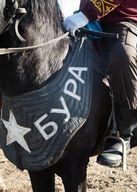
Kokpar in Kazakhstan - An ancient equestrian sport
Gabriel Gauffre / Le Pictorium
LePictorium_0278383.jpg
A crest with the name of a competition horse, "Bura".
Kokpar, a style of horse rugby, where the ball is a weighted goat corpse weighing about 55kg, has been practiced for almost a millennium in Central Asia, and was imported to Kazakhstan from the large intermingling of populations from China and Mongolia.
The goal: to fight for the possession of the ball (the goat), which can only be carried under the rider's leg, stuck against the saddle, and then throw it into a goal, designated on the ground by large circles of white powder. At the beginning of each round, in a fair atmosphere, the commentator announces the prize that will be won by the next scorer - a car, money, cattle, or even a camel.
Kokpar, a style of horse rugby, where the ball is a weighted goat corpse weighing about 55kg, has been practiced for almost a millennium in Central Asia, and was imported to Kazakhstan from the large intermingling of populations from China and Mongolia.
The goal: to fight for the possession of the ball (the goat), which can only be carried under the rider's leg, stuck against the saddle, and then throw it into a goal, designated on the ground by large circles of white powder. At the beginning of each round, in a fair atmosphere, the commentator announces the prize that will be won by the next scorer - a car, money, cattle, or even a camel.

Kokpar in Kazakhstan - An ancient equestrian sport
Gabriel Gauffre / Le Pictorium
LePictorium_0278384.jpg
During the most complicated scrimmages, a drone helps with the refereeing.
Kokpar, a style of horse rugby, where the ball is a weighted goat corpse weighing about 55kg, has been practiced for almost a millennium in Central Asia, and was imported to Kazakhstan from the large intermingling of populations from China and Mongolia.
The goal: to fight for the possession of the ball (the goat), which can only be carried under the rider's leg, stuck against the saddle, and then throw it into a goal, designated on the ground by large circles of white powder. At the beginning of each round, in a fair atmosphere, the commentator announces the prize that will be won by the next scorer - a car, money, cattle, or even a camel.
Kokpar, a style of horse rugby, where the ball is a weighted goat corpse weighing about 55kg, has been practiced for almost a millennium in Central Asia, and was imported to Kazakhstan from the large intermingling of populations from China and Mongolia.
The goal: to fight for the possession of the ball (the goat), which can only be carried under the rider's leg, stuck against the saddle, and then throw it into a goal, designated on the ground by large circles of white powder. At the beginning of each round, in a fair atmosphere, the commentator announces the prize that will be won by the next scorer - a car, money, cattle, or even a camel.
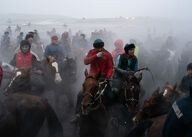
Kokpar in Kazakhstan - An ancient equestrian sport
Gabriel Gauffre / Le Pictorium
LePictorium_0278385.jpg
Kokpar players in the scrum.
Kokpar, a style of horse rugby, where the ball is a weighted goat corpse weighing about 55kg, has been practiced for almost a millennium in Central Asia, and was imported to Kazakhstan from the large intermingling of populations from China and Mongolia.
The goal: to fight for the possession of the ball (the goat), which can only be carried under the rider's leg, stuck against the saddle, and then throw it into a goal, designated on the ground by large circles of white powder. At the beginning of each round, in a fair atmosphere, the commentator announces the prize that will be won by the next scorer - a car, money, cattle, or even a camel.
Kokpar, a style of horse rugby, where the ball is a weighted goat corpse weighing about 55kg, has been practiced for almost a millennium in Central Asia, and was imported to Kazakhstan from the large intermingling of populations from China and Mongolia.
The goal: to fight for the possession of the ball (the goat), which can only be carried under the rider's leg, stuck against the saddle, and then throw it into a goal, designated on the ground by large circles of white powder. At the beginning of each round, in a fair atmosphere, the commentator announces the prize that will be won by the next scorer - a car, money, cattle, or even a camel.
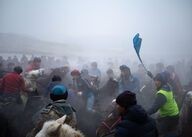
Kokpar in Kazakhstan - An ancient equestrian sport
Gabriel Gauffre / Le Pictorium
LePictorium_0278386.jpg
A referee raises his flag to signal a foul during a scrum.
Kokpar, a style of horse rugby, where the ball is a weighted goat corpse weighing about 55kg, has been practiced for almost a millennium in Central Asia, and was imported to Kazakhstan from the large intermingling of populations from China and Mongolia.
The goal: to fight for the possession of the ball (the goat), which can only be carried under the rider's leg, stuck against the saddle, and then throw it into a goal, designated on the ground by large circles of white powder. At the beginning of each round, in a fair atmosphere, the commentator announces the prize that will be won by the next scorer - a car, money, cattle, or even a camel.
Kokpar, a style of horse rugby, where the ball is a weighted goat corpse weighing about 55kg, has been practiced for almost a millennium in Central Asia, and was imported to Kazakhstan from the large intermingling of populations from China and Mongolia.
The goal: to fight for the possession of the ball (the goat), which can only be carried under the rider's leg, stuck against the saddle, and then throw it into a goal, designated on the ground by large circles of white powder. At the beginning of each round, in a fair atmosphere, the commentator announces the prize that will be won by the next scorer - a car, money, cattle, or even a camel.
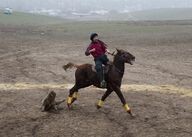
Kokpar in Kazakhstan - An ancient equestrian sport
Gabriel Gauffre / Le Pictorium
LePictorium_0278387.jpg
A player releases the goat into the goal.
Kokpar, a style of horse rugby, where the ball is a weighted goat corpse weighing about 55kg, has been practiced for almost a millennium in Central Asia, and was imported to Kazakhstan from the large intermingling of populations from China and Mongolia.
The goal: to fight for the possession of the ball (the goat), which can only be carried under the rider's leg, stuck against the saddle, and then throw it into a goal, designated on the ground by large circles of white powder. At the beginning of each round, in a fair atmosphere, the commentator announces the prize that will be won by the next scorer - a car, money, cattle, or even a camel.
Kokpar, a style of horse rugby, where the ball is a weighted goat corpse weighing about 55kg, has been practiced for almost a millennium in Central Asia, and was imported to Kazakhstan from the large intermingling of populations from China and Mongolia.
The goal: to fight for the possession of the ball (the goat), which can only be carried under the rider's leg, stuck against the saddle, and then throw it into a goal, designated on the ground by large circles of white powder. At the beginning of each round, in a fair atmosphere, the commentator announces the prize that will be won by the next scorer - a car, money, cattle, or even a camel.
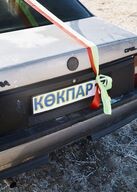
Kokpar in Kazakhstan - An ancient equestrian sport
Gabriel Gauffre / Le Pictorium
LePictorium_0278388.jpg
One of the prizes for the winners, a used Opel Vectra.
Kokpar, a style of horse rugby, where the ball is a weighted goat corpse weighing about 55kg, has been practiced for almost a millennium in Central Asia, and was imported to Kazakhstan from the large intermingling of populations from China and Mongolia.
The goal: to fight for the possession of the ball (the goat), which can only be carried under the rider's leg, stuck against the saddle, and then throw it into a goal, designated on the ground by large circles of white powder. At the beginning of each round, in a fair atmosphere, the commentator announces the prize that will be won by the next scorer - a car, money, cattle, or even a camel.
Kokpar, a style of horse rugby, where the ball is a weighted goat corpse weighing about 55kg, has been practiced for almost a millennium in Central Asia, and was imported to Kazakhstan from the large intermingling of populations from China and Mongolia.
The goal: to fight for the possession of the ball (the goat), which can only be carried under the rider's leg, stuck against the saddle, and then throw it into a goal, designated on the ground by large circles of white powder. At the beginning of each round, in a fair atmosphere, the commentator announces the prize that will be won by the next scorer - a car, money, cattle, or even a camel.
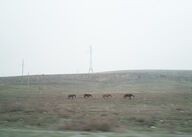
Kokpar in Kazakhstan - An ancient equestrian sport
Gabriel Gauffre / Le Pictorium
LePictorium_0278389.jpg
Wild horses on the road.
Kokpar, a style of horse rugby, where the ball is a weighted goat corpse weighing about 55kg, has been practiced for almost a millennium in Central Asia, and was imported to Kazakhstan from the large intermingling of populations from China and Mongolia.
The goal: to fight for the possession of the ball (the goat), which can only be carried under the rider's leg, stuck against the saddle, and then throw it into a goal, designated on the ground by large circles of white powder. At the beginning of each round, in a fair atmosphere, the commentator announces the prize that will be won by the next scorer - a car, money, cattle, or even a camel.
Kokpar, a style of horse rugby, where the ball is a weighted goat corpse weighing about 55kg, has been practiced for almost a millennium in Central Asia, and was imported to Kazakhstan from the large intermingling of populations from China and Mongolia.
The goal: to fight for the possession of the ball (the goat), which can only be carried under the rider's leg, stuck against the saddle, and then throw it into a goal, designated on the ground by large circles of white powder. At the beginning of each round, in a fair atmosphere, the commentator announces the prize that will be won by the next scorer - a car, money, cattle, or even a camel.
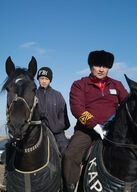
Kokpar in Kazakhstan - An ancient equestrian sport
Gabriel Gauffre / Le Pictorium
LePictorium_0278390.jpg
Two kokpar players. Some start early, from 13 years old.
Kokpar, a style of horse rugby, where the ball is a weighted goat corpse weighing about 55kg, has been practiced for almost a millennium in Central Asia, and was imported to Kazakhstan from the large intermingling of populations from China and Mongolia.
The goal: to fight for the possession of the ball (the goat), which can only be carried under the rider's leg, stuck against the saddle, and then throw it into a goal, designated on the ground by large circles of white powder. At the beginning of each round, in a fair atmosphere, the commentator announces the prize that will be won by the next scorer - a car, money, cattle, or even a camel.
Kokpar, a style of horse rugby, where the ball is a weighted goat corpse weighing about 55kg, has been practiced for almost a millennium in Central Asia, and was imported to Kazakhstan from the large intermingling of populations from China and Mongolia.
The goal: to fight for the possession of the ball (the goat), which can only be carried under the rider's leg, stuck against the saddle, and then throw it into a goal, designated on the ground by large circles of white powder. At the beginning of each round, in a fair atmosphere, the commentator announces the prize that will be won by the next scorer - a car, money, cattle, or even a camel.

Kokpar in Kazakhstan - An ancient equestrian sport
Gabriel Gauffre / Le Pictorium
LePictorium_0278391.jpg
The winner of a round of kokpar.
Kokpar, a style of horse rugby, where the ball is a weighted goat corpse weighing about 55kg, has been practiced for almost a millennium in Central Asia, and was imported to Kazakhstan from the large intermingling of populations from China and Mongolia.
The goal: to fight for the possession of the ball (the goat), which can only be carried under the rider's leg, stuck against the saddle, and then throw it into a goal, designated on the ground by large circles of white powder. At the beginning of each round, in a fair atmosphere, the commentator announces the prize that will be won by the next scorer - a car, money, cattle, or even a camel.
Kokpar, a style of horse rugby, where the ball is a weighted goat corpse weighing about 55kg, has been practiced for almost a millennium in Central Asia, and was imported to Kazakhstan from the large intermingling of populations from China and Mongolia.
The goal: to fight for the possession of the ball (the goat), which can only be carried under the rider's leg, stuck against the saddle, and then throw it into a goal, designated on the ground by large circles of white powder. At the beginning of each round, in a fair atmosphere, the commentator announces the prize that will be won by the next scorer - a car, money, cattle, or even a camel.
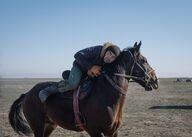
Kokpar in Kazakhstan - An ancient equestrian sport
Gabriel Gauffre / Le Pictorium
LePictorium_0278392.jpg
A kokpar player with his horse.
Kokpar, a style of horse rugby, where the ball is a weighted goat corpse weighing about 55kg, has been practiced for almost a millennium in Central Asia, and was imported to Kazakhstan from the large intermingling of populations from China and Mongolia.
The goal: to fight for the possession of the ball (the goat), which can only be carried under the rider's leg, stuck against the saddle, and then throw it into a goal, designated on the ground by large circles of white powder. At the beginning of each round, in a fair atmosphere, the commentator announces the prize that will be won by the next scorer - a car, money, cattle, or even a camel.
Kokpar, a style of horse rugby, where the ball is a weighted goat corpse weighing about 55kg, has been practiced for almost a millennium in Central Asia, and was imported to Kazakhstan from the large intermingling of populations from China and Mongolia.
The goal: to fight for the possession of the ball (the goat), which can only be carried under the rider's leg, stuck against the saddle, and then throw it into a goal, designated on the ground by large circles of white powder. At the beginning of each round, in a fair atmosphere, the commentator announces the prize that will be won by the next scorer - a car, money, cattle, or even a camel.
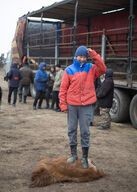
Kokpar in Kazakhstan - An ancient equestrian sport
Gabriel Gauffre / Le Pictorium
LePictorium_0278393.jpg
A child stands on the goat that will be used as a ball during a kokpar competition.
Kokpar, a style of horse rugby, where the ball is a weighted goat corpse weighing about 55kg, has been practiced for almost a millennium in Central Asia, and was imported to Kazakhstan from the large intermingling of populations from China and Mongolia.
The goal: to fight for the possession of the ball (the goat), which can only be carried under the rider's leg, stuck against the saddle, and then throw it into a goal, designated on the ground by large circles of white powder. At the beginning of each round, in a fair atmosphere, the commentator announces the prize that will be won by the next scorer - a car, money, cattle, or even a camel.
Kokpar, a style of horse rugby, where the ball is a weighted goat corpse weighing about 55kg, has been practiced for almost a millennium in Central Asia, and was imported to Kazakhstan from the large intermingling of populations from China and Mongolia.
The goal: to fight for the possession of the ball (the goat), which can only be carried under the rider's leg, stuck against the saddle, and then throw it into a goal, designated on the ground by large circles of white powder. At the beginning of each round, in a fair atmosphere, the commentator announces the prize that will be won by the next scorer - a car, money, cattle, or even a camel.
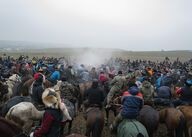
Kokpar in Kazakhstan - An ancient equestrian sport
Gabriel Gauffre / Le Pictorium
LePictorium_0278394.jpg
Kokpar players in the scrum.
Kokpar, a style of horse rugby, where the ball is a weighted goat corpse weighing about 55kg, has been practiced for almost a millennium in Central Asia, and was imported to Kazakhstan from the large intermingling of populations from China and Mongolia.
The goal: to fight for the possession of the ball (the goat), which can only be carried under the rider's leg, stuck against the saddle, and then throw it into a goal, designated on the ground by large circles of white powder. At the beginning of each round, in a fair atmosphere, the commentator announces the prize that will be won by the next scorer - a car, money, cattle, or even a camel.
Kokpar, a style of horse rugby, where the ball is a weighted goat corpse weighing about 55kg, has been practiced for almost a millennium in Central Asia, and was imported to Kazakhstan from the large intermingling of populations from China and Mongolia.
The goal: to fight for the possession of the ball (the goat), which can only be carried under the rider's leg, stuck against the saddle, and then throw it into a goal, designated on the ground by large circles of white powder. At the beginning of each round, in a fair atmosphere, the commentator announces the prize that will be won by the next scorer - a car, money, cattle, or even a camel.
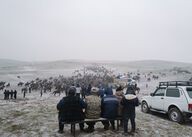
Kokpar in Kazakhstan - An ancient equestrian sport
Gabriel Gauffre / Le Pictorium
LePictorium_0278395.jpg
Spectators watch a kokpar match.
Kokpar, a style of horse rugby, where the ball is a weighted goat corpse weighing about 55kg, has been practiced for almost a millennium in Central Asia, and was imported to Kazakhstan from the large intermingling of populations from China and Mongolia.
The goal: to fight for the possession of the ball (the goat), which can only be carried under the rider's leg, stuck against the saddle, and then throw it into a goal, designated on the ground by large circles of white powder. At the beginning of each round, in a fair atmosphere, the commentator announces the prize that will be won by the next scorer - a car, money, cattle, or even a camel.
Kokpar, a style of horse rugby, where the ball is a weighted goat corpse weighing about 55kg, has been practiced for almost a millennium in Central Asia, and was imported to Kazakhstan from the large intermingling of populations from China and Mongolia.
The goal: to fight for the possession of the ball (the goat), which can only be carried under the rider's leg, stuck against the saddle, and then throw it into a goal, designated on the ground by large circles of white powder. At the beginning of each round, in a fair atmosphere, the commentator announces the prize that will be won by the next scorer - a car, money, cattle, or even a camel.
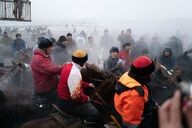
Kokpar in Kazakhstan - An ancient equestrian sport
Gabriel Gauffre / Le Pictorium
LePictorium_0278396.jpg
The winner of a round observes his prize.
Kokpar, a style of horse rugby, where the ball is a weighted goat corpse weighing about 55kg, has been practiced for almost a millennium in Central Asia, and was imported to Kazakhstan from the large intermingling of populations from China and Mongolia.
The goal: to fight for the possession of the ball (the goat), which can only be carried under the rider's leg, stuck against the saddle, and then throw it into a goal, designated on the ground by large circles of white powder. At the beginning of each round, in a fair atmosphere, the commentator announces the prize that will be won by the next scorer - a car, money, cattle, or even a camel.
Kokpar, a style of horse rugby, where the ball is a weighted goat corpse weighing about 55kg, has been practiced for almost a millennium in Central Asia, and was imported to Kazakhstan from the large intermingling of populations from China and Mongolia.
The goal: to fight for the possession of the ball (the goat), which can only be carried under the rider's leg, stuck against the saddle, and then throw it into a goal, designated on the ground by large circles of white powder. At the beginning of each round, in a fair atmosphere, the commentator announces the prize that will be won by the next scorer - a car, money, cattle, or even a camel.
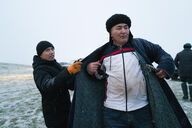
Kokpar in Kazakhstan - An ancient equestrian sport
Gabriel Gauffre / Le Pictorium
LePictorium_0278397.jpg
A kokpar player is about to leave at the end of a game.
Kokpar, a style of horse rugby, where the ball is a weighted goat corpse weighing about 55kg, has been practiced for almost a millennium in Central Asia, and was imported to Kazakhstan from the large intermingling of populations from China and Mongolia.
The goal: to fight for the possession of the ball (the goat), which can only be carried under the rider's leg, stuck against the saddle, and then throw it into a goal, designated on the ground by large circles of white powder. At the beginning of each round, in a fair atmosphere, the commentator announces the prize that will be won by the next scorer - a car, money, cattle, or even a camel.
Kokpar, a style of horse rugby, where the ball is a weighted goat corpse weighing about 55kg, has been practiced for almost a millennium in Central Asia, and was imported to Kazakhstan from the large intermingling of populations from China and Mongolia.
The goal: to fight for the possession of the ball (the goat), which can only be carried under the rider's leg, stuck against the saddle, and then throw it into a goal, designated on the ground by large circles of white powder. At the beginning of each round, in a fair atmosphere, the commentator announces the prize that will be won by the next scorer - a car, money, cattle, or even a camel.
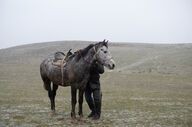
Kokpar in Kazakhstan - An ancient equestrian sport
Gabriel Gauffre / Le Pictorium
LePictorium_0278398.jpg
A kokpar player with his horse.
Kokpar, a style of horse rugby, where the ball is a weighted goat corpse weighing about 55kg, has been practiced for almost a millennium in Central Asia, and was imported to Kazakhstan from the large intermingling of populations from China and Mongolia.
The goal: to fight for the possession of the ball (the goat), which can only be carried under the rider's leg, stuck against the saddle, and then throw it into a goal, designated on the ground by large circles of white powder. At the beginning of each round, in a fair atmosphere, the commentator announces the prize that will be won by the next scorer - a car, money, cattle, or even a camel.
Kokpar, a style of horse rugby, where the ball is a weighted goat corpse weighing about 55kg, has been practiced for almost a millennium in Central Asia, and was imported to Kazakhstan from the large intermingling of populations from China and Mongolia.
The goal: to fight for the possession of the ball (the goat), which can only be carried under the rider's leg, stuck against the saddle, and then throw it into a goal, designated on the ground by large circles of white powder. At the beginning of each round, in a fair atmosphere, the commentator announces the prize that will be won by the next scorer - a car, money, cattle, or even a camel.

Kokpar in Kazakhstan - An ancient equestrian sport
Gabriel Gauffre / Le Pictorium
LePictorium_0278399.jpg
A kokpar player leaves with his prize.
Kokpar, a style of horse rugby, where the ball is a weighted goat corpse weighing about 55kg, has been practiced for almost a millennium in Central Asia, and was imported to Kazakhstan from the large intermingling of populations from China and Mongolia.
The goal: to fight for the possession of the ball (the goat), which can only be carried under the rider's leg, stuck against the saddle, and then throw it into a goal, designated on the ground by large circles of white powder. At the beginning of each round, in a fair atmosphere, the commentator announces the prize that will be won by the next scorer - a car, money, cattle, or even a camel.
Kokpar, a style of horse rugby, where the ball is a weighted goat corpse weighing about 55kg, has been practiced for almost a millennium in Central Asia, and was imported to Kazakhstan from the large intermingling of populations from China and Mongolia.
The goal: to fight for the possession of the ball (the goat), which can only be carried under the rider's leg, stuck against the saddle, and then throw it into a goal, designated on the ground by large circles of white powder. At the beginning of each round, in a fair atmosphere, the commentator announces the prize that will be won by the next scorer - a car, money, cattle, or even a camel.

Kokpar in Kazakhstan - An ancient equestrian sport
Gabriel Gauffre / Le Pictorium
LePictorium_0278400.jpg
Kokpar players between two games.
Kokpar, a style of horse rugby, where the ball is a weighted goat corpse weighing about 55kg, has been practiced for almost a millennium in Central Asia, and was imported to Kazakhstan from the large intermingling of populations from China and Mongolia.
The goal: to fight for the possession of the ball (the goat), which can only be carried under the rider's leg, stuck against the saddle, and then throw it into a goal, designated on the ground by large circles of white powder. At the beginning of each round, in a fair atmosphere, the commentator announces the prize that will be won by the next scorer - a car, money, cattle, or even a camel.
Kokpar, a style of horse rugby, where the ball is a weighted goat corpse weighing about 55kg, has been practiced for almost a millennium in Central Asia, and was imported to Kazakhstan from the large intermingling of populations from China and Mongolia.
The goal: to fight for the possession of the ball (the goat), which can only be carried under the rider's leg, stuck against the saddle, and then throw it into a goal, designated on the ground by large circles of white powder. At the beginning of each round, in a fair atmosphere, the commentator announces the prize that will be won by the next scorer - a car, money, cattle, or even a camel.
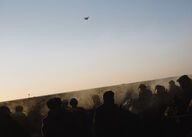
Kokpar in Kazakhstan - An ancient equestrian sport
Gabriel Gauffre / Le Pictorium
LePictorium_0278401.jpg
Kokpar players in the scrum.
Kokpar, a style of horse rugby, where the ball is a weighted goat corpse weighing about 55kg, has been practiced for almost a millennium in Central Asia, and was imported to Kazakhstan from the large intermingling of populations from China and Mongolia.
The goal: to fight for the possession of the ball (the goat), which can only be carried under the rider's leg, stuck against the saddle, and then throw it into a goal, designated on the ground by large circles of white powder. At the beginning of each round, in a fair atmosphere, the commentator announces the prize that will be won by the next scorer - a car, money, cattle, or even a camel.
Kokpar, a style of horse rugby, where the ball is a weighted goat corpse weighing about 55kg, has been practiced for almost a millennium in Central Asia, and was imported to Kazakhstan from the large intermingling of populations from China and Mongolia.
The goal: to fight for the possession of the ball (the goat), which can only be carried under the rider's leg, stuck against the saddle, and then throw it into a goal, designated on the ground by large circles of white powder. At the beginning of each round, in a fair atmosphere, the commentator announces the prize that will be won by the next scorer - a car, money, cattle, or even a camel.
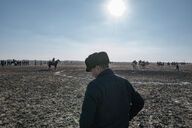
Kokpar in Kazakhstan - An ancient equestrian sport
Gabriel Gauffre / Le Pictorium
LePictorium_0278402.jpg
A spectator watches a kokpar match.
Kokpar, a style of horse rugby, where the ball is a weighted goat corpse weighing about 55kg, has been practiced for almost a millennium in Central Asia, and was imported to Kazakhstan from the large intermingling of populations from China and Mongolia.
The goal: to fight for the possession of the ball (the goat), which can only be carried under the rider's leg, stuck against the saddle, and then throw it into a goal, designated on the ground by large circles of white powder. At the beginning of each round, in a fair atmosphere, the commentator announces the prize that will be won by the next scorer - a car, money, cattle, or even a camel.
Kokpar, a style of horse rugby, where the ball is a weighted goat corpse weighing about 55kg, has been practiced for almost a millennium in Central Asia, and was imported to Kazakhstan from the large intermingling of populations from China and Mongolia.
The goal: to fight for the possession of the ball (the goat), which can only be carried under the rider's leg, stuck against the saddle, and then throw it into a goal, designated on the ground by large circles of white powder. At the beginning of each round, in a fair atmosphere, the commentator announces the prize that will be won by the next scorer - a car, money, cattle, or even a camel.
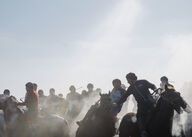
Kokpar in Kazakhstan - An ancient equestrian sport
Gabriel Gauffre / Le Pictorium
LePictorium_0278403.jpg
Kokpar players in the scrum.
Kokpar, a style of horse rugby, where the ball is a weighted goat corpse weighing about 55kg, has been practiced for almost a millennium in Central Asia, and was imported to Kazakhstan from the large intermingling of populations from China and Mongolia.
The goal: to fight for the possession of the ball (the goat), which can only be carried under the rider's leg, stuck against the saddle, and then throw it into a goal, designated on the ground by large circles of white powder. At the beginning of each round, in a fair atmosphere, the commentator announces the prize that will be won by the next scorer - a car, money, cattle, or even a camel.
Kokpar, a style of horse rugby, where the ball is a weighted goat corpse weighing about 55kg, has been practiced for almost a millennium in Central Asia, and was imported to Kazakhstan from the large intermingling of populations from China and Mongolia.
The goal: to fight for the possession of the ball (the goat), which can only be carried under the rider's leg, stuck against the saddle, and then throw it into a goal, designated on the ground by large circles of white powder. At the beginning of each round, in a fair atmosphere, the commentator announces the prize that will be won by the next scorer - a car, money, cattle, or even a camel.
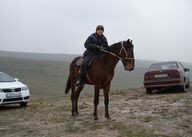
Kokpar in Kazakhstan - An ancient equestrian sport
Gabriel Gauffre / Le Pictorium
LePictorium_0278404.jpg
A kokpar player with his horse.
Kokpar, a style of horse rugby, where the ball is a weighted goat corpse weighing about 55kg, has been practiced for almost a millennium in Central Asia, and was imported to Kazakhstan from the large intermingling of populations from China and Mongolia.
The goal: to fight for the possession of the ball (the goat), which can only be carried under the rider's leg, stuck against the saddle, and then throw it into a goal, designated on the ground by large circles of white powder. At the beginning of each round, in a fair atmosphere, the commentator announces the prize that will be won by the next scorer - a car, money, cattle, or even a camel.
Kokpar, a style of horse rugby, where the ball is a weighted goat corpse weighing about 55kg, has been practiced for almost a millennium in Central Asia, and was imported to Kazakhstan from the large intermingling of populations from China and Mongolia.
The goal: to fight for the possession of the ball (the goat), which can only be carried under the rider's leg, stuck against the saddle, and then throw it into a goal, designated on the ground by large circles of white powder. At the beginning of each round, in a fair atmosphere, the commentator announces the prize that will be won by the next scorer - a car, money, cattle, or even a camel.
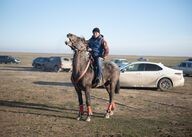
Kokpar in Kazakhstan - An ancient equestrian sport
Gabriel Gauffre / Le Pictorium
LePictorium_0278405.jpg
A kokpar player with his horse.
Kokpar, a style of horse rugby, where the ball is a weighted goat corpse weighing about 55kg, has been practiced for almost a millennium in Central Asia, and was imported to Kazakhstan from the large intermingling of populations from China and Mongolia.
The goal: to fight for the possession of the ball (the goat), which can only be carried under the rider's leg, stuck against the saddle, and then throw it into a goal, designated on the ground by large circles of white powder. At the beginning of each round, in a fair atmosphere, the commentator announces the prize that will be won by the next scorer - a car, money, cattle, or even a camel.
Kokpar, a style of horse rugby, where the ball is a weighted goat corpse weighing about 55kg, has been practiced for almost a millennium in Central Asia, and was imported to Kazakhstan from the large intermingling of populations from China and Mongolia.
The goal: to fight for the possession of the ball (the goat), which can only be carried under the rider's leg, stuck against the saddle, and then throw it into a goal, designated on the ground by large circles of white powder. At the beginning of each round, in a fair atmosphere, the commentator announces the prize that will be won by the next scorer - a car, money, cattle, or even a camel.
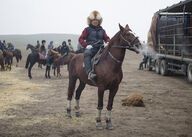
Kokpar in Kazakhstan - An ancient equestrian sport
Gabriel Gauffre / Le Pictorium
LePictorium_0278406.jpg
A kokpar player with his horse.
Kokpar, a style of horse rugby, where the ball is a weighted goat corpse weighing about 55kg, has been practiced for almost a millennium in Central Asia, and was imported to Kazakhstan from the large intermingling of populations from China and Mongolia.
The goal: to fight for the possession of the ball (the goat), which can only be carried under the rider's leg, stuck against the saddle, and then throw it into a goal, designated on the ground by large circles of white powder. At the beginning of each round, in a fair atmosphere, the commentator announces the prize that will be won by the next scorer - a car, money, cattle, or even a camel.
Kokpar, a style of horse rugby, where the ball is a weighted goat corpse weighing about 55kg, has been practiced for almost a millennium in Central Asia, and was imported to Kazakhstan from the large intermingling of populations from China and Mongolia.
The goal: to fight for the possession of the ball (the goat), which can only be carried under the rider's leg, stuck against the saddle, and then throw it into a goal, designated on the ground by large circles of white powder. At the beginning of each round, in a fair atmosphere, the commentator announces the prize that will be won by the next scorer - a car, money, cattle, or even a camel.

Kokpar in Kazakhstan - An ancient equestrian sport
Gabriel Gauffre / Le Pictorium
LePictorium_0278407.jpg
A kokpar player with his horse.
Kokpar, a style of horse rugby, where the ball is a weighted goat corpse weighing about 55kg, has been practiced for almost a millennium in Central Asia, and was imported to Kazakhstan from the large intermingling of populations from China and Mongolia.
The goal: to fight for the possession of the ball (the goat), which can only be carried under the rider's leg, stuck against the saddle, and then throw it into a goal, designated on the ground by large circles of white powder. At the beginning of each round, in a fair atmosphere, the commentator announces the prize that will be won by the next scorer - a car, money, cattle, or even a camel.
Kokpar, a style of horse rugby, where the ball is a weighted goat corpse weighing about 55kg, has been practiced for almost a millennium in Central Asia, and was imported to Kazakhstan from the large intermingling of populations from China and Mongolia.
The goal: to fight for the possession of the ball (the goat), which can only be carried under the rider's leg, stuck against the saddle, and then throw it into a goal, designated on the ground by large circles of white powder. At the beginning of each round, in a fair atmosphere, the commentator announces the prize that will be won by the next scorer - a car, money, cattle, or even a camel.
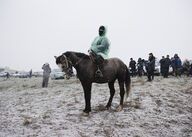
Kokpar in Kazakhstan - An ancient equestrian sport
Gabriel Gauffre / Le Pictorium
LePictorium_0278408.jpg
A kokpar player with his horse.
Kokpar, a style of horse rugby, where the ball is a weighted goat corpse weighing about 55kg, has been practiced for almost a millennium in Central Asia, and was imported to Kazakhstan from the large intermingling of populations from China and Mongolia.
The goal: to fight for the possession of the ball (the goat), which can only be carried under the rider's leg, stuck against the saddle, and then throw it into a goal, designated on the ground by large circles of white powder. At the beginning of each round, in a fair atmosphere, the commentator announces the prize that will be won by the next scorer - a car, money, cattle, or even a camel.
Kokpar, a style of horse rugby, where the ball is a weighted goat corpse weighing about 55kg, has been practiced for almost a millennium in Central Asia, and was imported to Kazakhstan from the large intermingling of populations from China and Mongolia.
The goal: to fight for the possession of the ball (the goat), which can only be carried under the rider's leg, stuck against the saddle, and then throw it into a goal, designated on the ground by large circles of white powder. At the beginning of each round, in a fair atmosphere, the commentator announces the prize that will be won by the next scorer - a car, money, cattle, or even a camel.

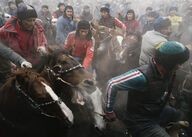 Kokpar
Kokpar